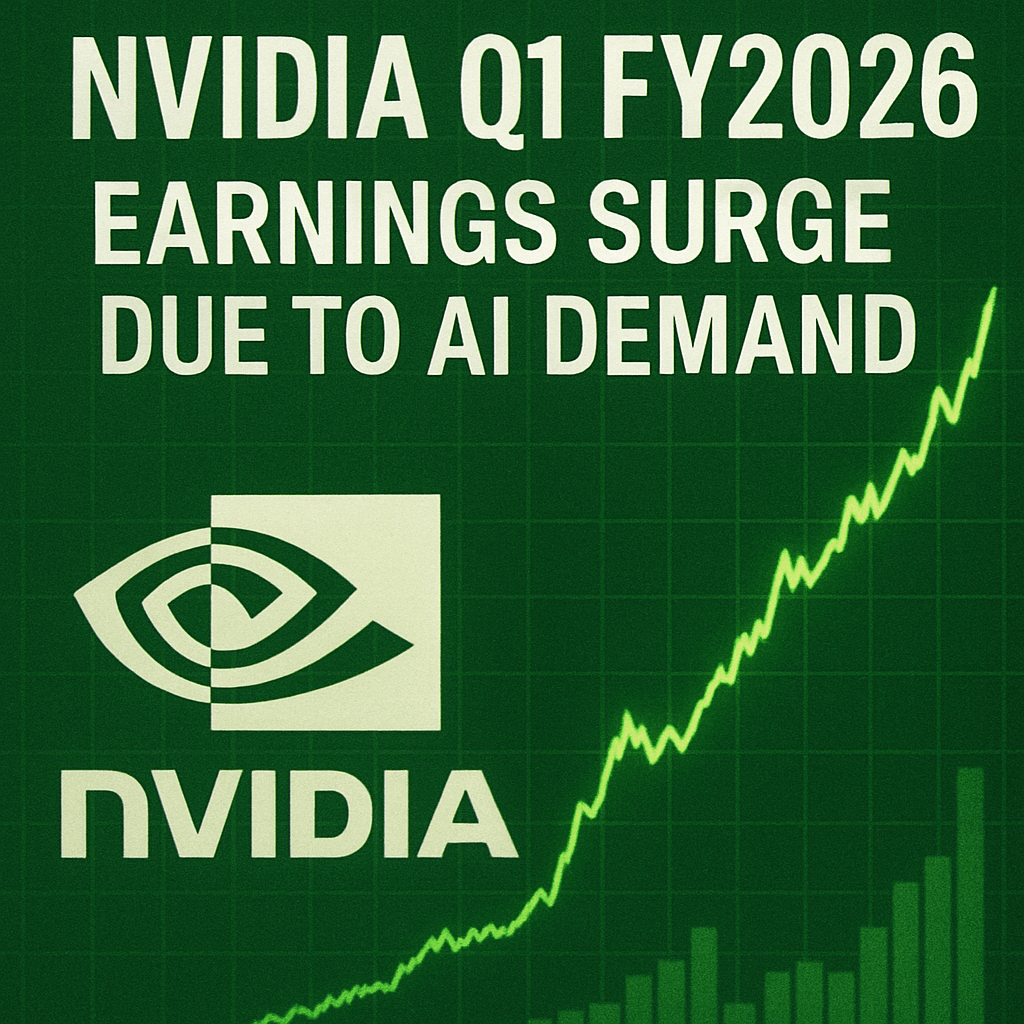Nvidia Q1 FY2026 Earnings Surge Due to AI Demand

Nvidia reported first-quarter results for fiscal 2026 that comfortably outpaced Wall Street forecasts, even after absorbing an estimated $8 billion (€7.1 billion) hit from U.S. export restrictions on chip shipments to China. The company’s shares jumped nearly 5% in after-hours trading, leaving the stock just 8% below its January all-time high. Year-to-date, Nvidia is on track for a positive return amid surging demand for AI compute.
Upbeat Earnings Results
Data centre revenue climbed 73% year-on-year to $39.1 billion (€34.7 billion), setting a new quarterly record. Although this represented a deceleration from the prior quarter’s 93% expansion, the figure met consensus estimates as investors had factored in regulatory headwinds. Total revenue rose 69% to $44.1 billion (€39.2 billion), while non-GAAP earnings per share stood at $0.96 (€0.85), both exceeding analyst projections.
Segment Breakdown
- Data Centre: $39.1 billion, +73% YoY
- Gaming: $4.7 billion, +15% YoY, driven by new Ada Lovelace GPUs
- Professional Visualization: $1.2 billion, +10% YoY
- Automotive & Edge: $750 million, +25% YoY
“Global demand for Nvidia’s AI infrastructure is incredibly strong. AI inference token generation has surged tenfold in one year,” said CEO Jensen Huang.
Impact of Export Restrictions
Nvidia guided Q2 revenue at $45 billion (€40 billion), ±2%, a projection that reflects a roughly $8 billion shortfall in H20 GPU sales to China due to newly imposed U.S. export controls. Although H20 chips were previously unrestricted, the Department of Commerce now requires specific licenses, resulting in $4.5 billion (€4 billion) of inventory write-downs and a $2.5 billion (€2.2 billion) revenue gap.
The company’s GAAP gross margin contracted to 61% from 71.3% pro forma, had charges not occurred. Nvidia expects a non-GAAP gross margin of 72.0% ±50 bps in the current quarter, compared with 73.5% in Q4 FY2025.
Geopolitical Implications
The export curbs underscore intensifying U.S.-China tech competition. By restricting advanced computing chips, regulators aim to slow China’s AI development while steering domestic supply chains onshore. Nvidia is exploring workarounds—pending U.S. approval—to repurpose or redesign H20 inventory for alternative markets.
Technical Deep Dive: Blackwell Architecture
Nvidia’s newest flagship, the Blackwell GPU, is now in full production. Built on a 5 nm process node, Blackwell integrates 200 billion transistors—up 40% from its predecessor—and introduces the DPX++ tensor engine, optimized for transformer inference. Multi-Instance GPU (MIG) enhancements allow cloud providers to partition a single chip into up to 24 independent instances, boosting utilization rates in hyperscale data centres.
Strategic Partnerships and Global Expansion
On the geopolitical front, Nvidia joined President Trump’s White House AI initiative in January, pledging R&D investments in U.S. fabrication facilities. In the Middle East, the company forged a partnership with Saudi Arabia’s HUMAIN to erect AI “fabless factories” capable of integrating Blackwell GPUs into local cloud and telecom networks. These alliances diversify Nvidia’s revenue base as China contracts.
Outlook and Analyst Commentary
Revenue guidance of $45 billion ±2% contains upside from license approvals and potential H20 chip rerouting. Analysts at eToro Australia note, “Investors sought reassurance on short-term headwinds and received a clear signal that AI demand remains robust.” Bernstein strategist Tim Long adds, “With hyperscale customers signing multi-year AI compute deals, Nvidia’s growth runway extends well into FY2027.”
Risks and Considerations
- Regulatory uncertainty in export controls and licensing timelines
- Competition from AMD’s Genoa AI and Intel’s Gaudi accelerators
- Supply chain constraints in advanced packaging and memory modules
- Potential margin pressure from rising wafer and interconnect costs
Conclusion
Nvidia’s first-quarter performance underscores its leadership in AI compute, buoyed by sustained data centre demand and cutting-edge GPU architectures. While U.S. export curbs to China introduce near-term challenges, strategic partnerships in the Middle East and increased domestic fab support position Nvidia for continued outperformance.